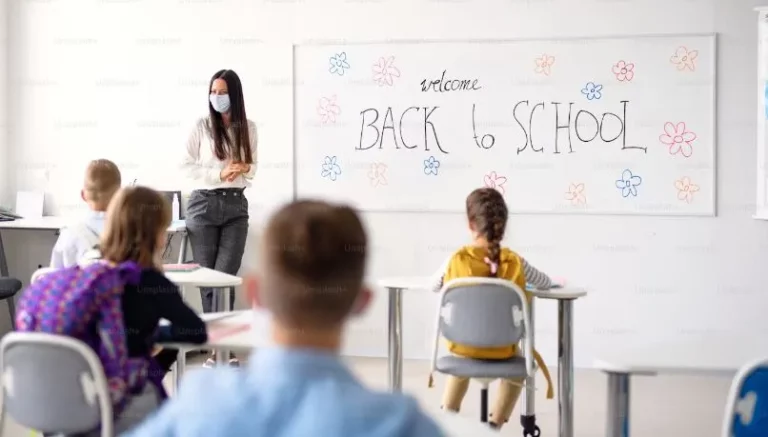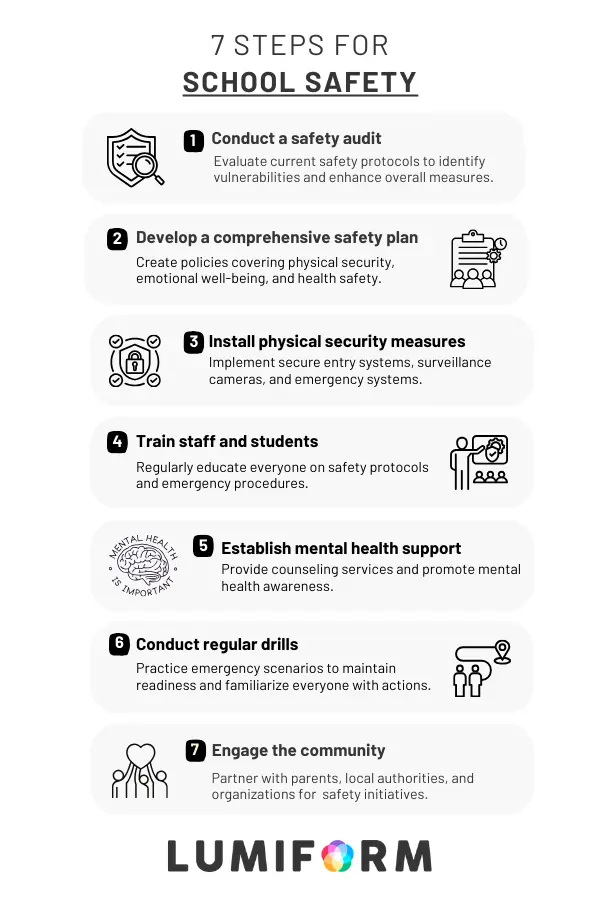Ensuring the safety of everyone within a school, from students to staff, and visitors, is a top priority for everyone. Moreover, it becomes even more critical if you’re an educator, administrator, parent, or community member. This guide is crafted specifically for you, addressing the unique concerns and responsibilities you hold in safeguarding our educational environments.
The latest findings from the CDC’s Youth Risk Behavior Surveillance (YRBS) highlight the increasing threats faced by schools, with risks varying across regions. Whether you’re directly involved in school operations or play a supportive role, this guide equips you with essential insights into school safety.
Prepare to explore definitions, core principles, implementation steps, best practices, and compliance measures. Get ready to contribute to a secure and conducive learning atmosphere.
What is school safety?
School safety encompasses a comprehensive approach to safeguarding the well-being of everyone within your school community. Safety in this sense, goes beyond physical security measures like secure entry points and surveillance systems. It also extends to creating a supportive environment that addresses emotional and psychological needs.
Initiatives such as counseling services, anti-bullying programs, and mental health awareness campaigns are crucial components.
Additionally, preparedness for emergencies through regular drills and effective communication strategies ensures prompt and coordinated responses. Fostering a culture of safety and support helps schools protect individuals.
In the same vein, it promotes a positive learning environment where students can thrive academically and socially.
How to advocate for school safety
Advocating for school safety requires a holistic approach that includes physical security measures, emergency preparedness, mental health support, and a positive school climate. Implementing surveillance systems, secure entrances, and regular safety drills ensures physical security.
On the other hand, comprehensive emergency response plans and drills with local law enforcement enhance preparedness.
Likewise, adopting documentation systems and action plans on allergens can present a school as more thoughtful and proactive.
Offering counseling and staff training supports student mental health and combats bullying. Engaging the school community in safety discussions fosters collaboration, creating a secure learning environment for all.
Principles of school safety
School safety relies on key principles that address physical security, emotional well-being, risk assessment, and effective emergency management.
Addressing safety in all dimensions: Physical, emotional, and proactive measures
First, enhance physical safety by securing buildings, installing surveillance systems, and controlling access points. Next, support emotional well-being by offering comprehensive counseling services, mental health programs, and robust anti-bullying initiatives.
To prepare for crises, develop detailed emergency plans, and conduct regular drills for fires, natural disasters, and active shooter scenarios.
Additionally, advocate for health safety through strict hygiene practices, regular sanitation, and vaccination requirements.
Mental health awareness
Furthermore, foster a culture of inclusivity and respect to ensure every student feels valued and supported. Train staff and students in conflict resolution, mental health awareness, and first aid. Promote open communication channels between students, parents, and school authorities to promptly address concerns.
Focusing on these areas creates a secure learning environment where students thrive academically, socially, and emotionally.
Regularly review and update safety protocols to adapt to new challenges and ensure ongoing protection for the school community.
Step-by-step guide to implementing school safety
- Conduct a safety audit: Start by evaluating your current safety protocols. Identify vulnerabilities that need addressing to enhance overall safety measures.
- Develop a comprehensive safety plan: Create robust policies and procedures that cover physical security, emotional well-being, and health safety for a holistic approach.
- Install physical security measures: Implement secure entry systems, surveillance cameras, and reliable emergency communication systems to strengthen physical security.
- Train staff and students: Regularly educate staff and students on safety protocols and emergency procedures to ensure preparedness and effective crisis response.
- Establish mental health support: Provide access to counseling services and promote mental health awareness programs to support emotional well-being.
- Conduct regular drills: Practice emergency response scenarios through regular drills to maintain readiness and familiarize everyone with appropriate actions.
- Engage the community: Build partnerships with parents, local authorities, and community organizations to collaborate on safety initiatives for a unified effort.
Best practices for school safety
Implementing best practices for school safety is crucial for establishing a secure and supportive learning environment. Regular training sessions are essential to equip staff and students with the skills and readiness to assess and effectively respond to potential threats and emergencies.
Clear and open communication with stakeholders ensures that safety concerns are swiftly addressed and resolved, fostering a proactive approach to maintaining safety.
Inclusive policies play a vital role in accommodating the diverse needs of all students, promoting inclusivity, and enhancing overall safety within the school community.
Furthermore, continuous improvement through regular updates to safety plans based on feedback and emerging challenges ensures that safety measures remain effective and adaptive. By consistently refining and enhancing safety protocols, schools can uphold a culture of safety that prioritizes the well-being of everyone involved in the educational environment.
How to implement school safety in your organization
Advocating school safety in your organization involves several critical steps to create a secure and supportive environment for everyone. First, strong leadership commitment is essential to prioritize and actively support safety initiatives, establishing a culture where safety is a top priority.
Again, collaborative efforts with teachers, staff, students, and parents are crucial for developing and implementing comprehensive safety measures, ensuring everyone feels a sense of ownership and responsibility. Allocating necessary resources for agile risk assessment, training, equipment, and mental health support is vital for maintaining a proactive and supportive environment. Regular reviews and updates of safety policies help adapt to new trends and technologies, ensuring continuous improvement.
By following these steps, schools can foster a secure environment that supports the well-being and success of the entire school community, engaging everyone in the collective effort to maintain safety and readiness.
How to comply with school safety guidelines
Complying with school safety guidelines involves staying informed about local, state, and federal regulations, maintaining thorough documentation of safety audits, training sessions, and incident reports, and conducting regular safety audits to ensure ongoing compliance. Consulting with safety experts and local authorities helps ensure that best practices are followed.
Additionally, creating a safety culture that encourages comprehensive anti-cyberbullying policies and educating students on digital citizenship is vital. Schools can go further by providing support for victims, encouraging incident reporting, and enforcing clear consequences for perpetrators to create a safer online environment.
For physical safety, immediately removing or restricting access to unsafe playground equipment and arranging for repairs or replacements is necessary. Regular inspections ensure a safe playground for children. Likewise, structures must also consider natural disaster preparedness.
In disaster-prone areas, developing and regularly updating an emergency response plan with evacuation routes, communication protocols, and designated safe areas is essential. Conducting regular drills and collaborating with local emergency services enhance preparedness and response.
Benefits for your school/staff
Here are some of the key advantages:
- Enhanced Security: Improved safety measures create a secure environment, fostering a focus on teaching and learning without fear of harm.
- Positive School Climate: A safe environment promotes student engagement and academic performance while supporting teacher satisfaction and productivity.
- Community Trust & Engagement: Commitment to safety builds trust, enhances community involvement, and strengthens school reputation and enrollment.
- Preparedness: Effective safety plans ensure readiness for emergencies, minimizing disruptions to education and ensuring staff and student safety.
- Staff Morale and Retention: A safe working environment boosts morale, reduces turnover, and supports long-term staff commitment and satisfaction.
In summary, prioritizing school safety offers comprehensive benefits. It enhances security and fosters a positive school climate. It builds community trust and ensures preparedness. School safety boosts staff morale and provides legal and financial protection. It also improves learning outcomes and increases parental and community engagement. These advantages collectively create a thriving educational environment where students, staff, and the community can flourish.
Take action for your school safety with Lumiform today
Reflect on the importance of school safety and take decisive action. Use Lumiform’s platform to explore and implement strategies today.
Begin with our rich template creation tools, libraries, automation features, and audits. Elevate safety standards and audit your school in areas needing improvement and compliance.
Click here to start today and transform your approach to school safety.

